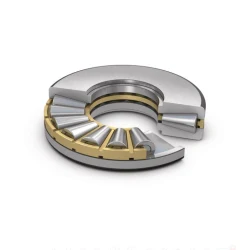Types of thrust bearings
2023-12-04
Thrust bearings are a type of bearing specifically designed to support axial loads (force acting parallel to the shaft). These bearings are crucial in applications where there is a need to accommodate axial loads while allowing for rotation. There are different types of thrust bearings, each with its own design and characteristics. Here are some common types of thrust bearings:
1. Thrust Ball Bearings:
- Consist of a set of balls sandwiched between two washers (analogous to races).
- Suitable for applications with relatively low axial loads and high-speed rotations.
- Available in both single-direction and double-direction configurations.
2. Thrust Roller Bearings:
- Use cylindrical or tapered rollers to support axial loads.
- Suitable for applications with higher axial loads and lower speeds compared to thrust ball bearings.
- Available in various designs, including cylindrical thrust roller bearings and tapered thrust roller bearings.
3. Spherical Roller Thrust Bearings:
- Combine the characteristics of thrust bearings and spherical roller bearings.
- Can accommodate misalignment and are suitable for applications with heavy axial loads.
- Commonly used in applications such as heavy-duty machinery and large gearboxes.
4. Tapered Roller Thrust Bearings:
- Use tapered rollers similar to those in tapered roller bearings.
- Can support high axial loads and handle moderate radial loads.
- Often used in applications like automotive transmissions.
5. Needle Roller Thrust Bearings:
- Utilize needle-shaped rollers to support axial loads in a compact design.
- Suitable for applications with limited axial space and high axial loads, such as automotive transmissions.
6. Ball Thrust Bearings:
- Similar to thrust ball bearings but with additional features for higher load-carrying capacity.
- Used in applications where axial loads need to be supported in one direction.
7. Cylindrical Roller Thrust Bearings:
- Use cylindrical rollers and can accommodate high axial loads.
- Suitable for applications with relatively high speeds and heavy axial loads.
8. Fluid Bearings:
- Utilize a fluid (liquid or gas) to support axial loads.
- Commonly used in applications with very high speeds, such as in some high-performance machinery.
9. Magnetic Thrust Bearings:
- Use magnetic fields to support axial loads without physical contact.
- Suitable for high-speed and precision applications.
The choice of thrust bearing depends on factors such as the magnitude and direction of the axial load, speed, available space, and the specific requirements of the application. Proper lubrication is essential for thrust bearings to ensure smooth operation and prevent premature wear.



